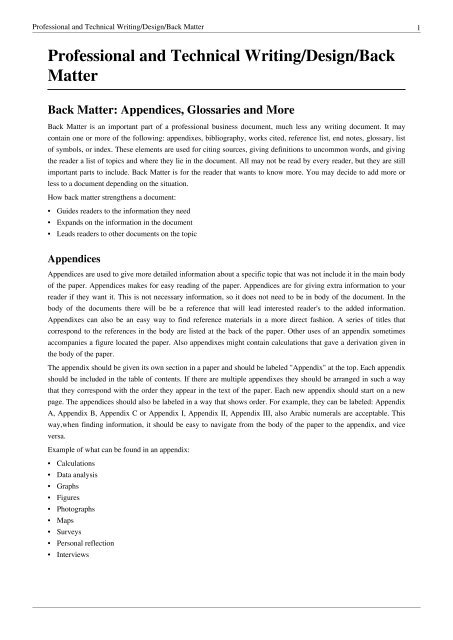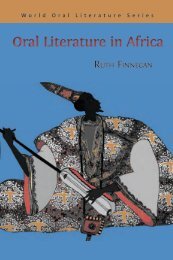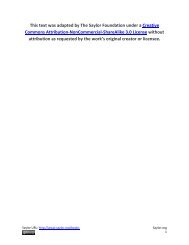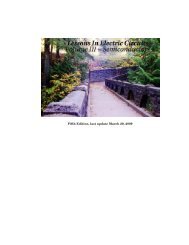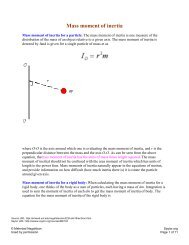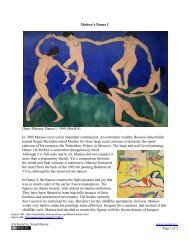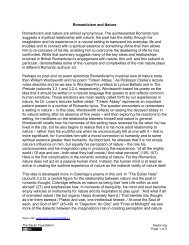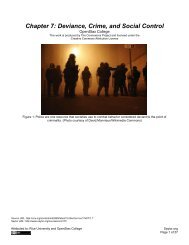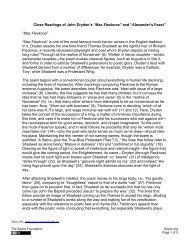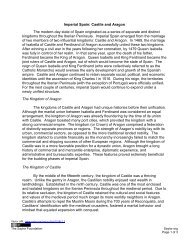Professional and Technical Writing/Design/Back Matter - Saylor.org
Professional and Technical Writing/Design/Back Matter - Saylor.org
Professional and Technical Writing/Design/Back Matter - Saylor.org
You also want an ePaper? Increase the reach of your titles
YUMPU automatically turns print PDFs into web optimized ePapers that Google loves.
<strong>Professional</strong> <strong>and</strong> <strong>Technical</strong> <strong>Writing</strong>/<strong>Design</strong>/<strong>Back</strong> <strong>Matter</strong> 1<br />
<strong>Professional</strong> <strong>and</strong> <strong>Technical</strong> <strong>Writing</strong>/<strong>Design</strong>/<strong>Back</strong><br />
<strong>Matter</strong><br />
<strong>Back</strong> <strong>Matter</strong>: Appendices, Glossaries <strong>and</strong> More<br />
<strong>Back</strong> <strong>Matter</strong> is an important part of a professional business document, much less any writing document. It may<br />
contain one or more of the following: appendixes, bibliography, works cited, reference list, end notes, glossary, list<br />
of symbols, or index. These elements are used for citing sources, giving definitions to uncommon words, <strong>and</strong> giving<br />
the reader a list of topics <strong>and</strong> where they lie in the document. All may not be read by every reader, but they are still<br />
important parts to include. <strong>Back</strong> <strong>Matter</strong> is for the reader that wants to know more. You may decide to add more or<br />
less to a document depending on the situation.<br />
How back matter strengthens a document:<br />
• Guides readers to the information they need<br />
• Exp<strong>and</strong>s on the information in the document<br />
• Leads readers to other documents on the topic<br />
Appendices<br />
Appendices are used to give more detailed information about a specific topic that was not include it in the main body<br />
of the paper. Appendices makes for easy reading of the paper. Appendices are for giving extra information to your<br />
reader if they want it. This is not necessary information, so it does not need to be in body of the document. In the<br />
body of the documents there will be be a reference that will lead interested reader's to the added information.<br />
Appendixes can also be an easy way to find reference materials in a more direct fashion. A series of titles that<br />
correspond to the references in the body are listed at the back of the paper. Other uses of an appendix sometimes<br />
accompanies a figure located the paper. Also appendixes might contain calculations that gave a derivation given in<br />
the body of the paper.<br />
The appendix should be given its own section in a paper <strong>and</strong> should be labeled "Appendix" at the top. Each appendix<br />
should be included in the table of contents. If there are multiple appendixes they should be arranged in such a way<br />
that they correspond with the order they appear in the text of the paper. Each new appendix should start on a new<br />
page. The appendices should also be labeled in a way that shows order. For example, they can be labeled: Appendix<br />
A, Appendix B, Appendix C or Appendix I, Appendix II, Appendix III, also Arabic numerals are acceptable. This<br />
way,when finding information, it should be easy to navigate from the body of the paper to the appendix, <strong>and</strong> vice<br />
versa.<br />
Example of what can be found in an appendix:<br />
• Calculations<br />
• Data analysis<br />
• Graphs<br />
• Figures<br />
• Photographs<br />
• Maps<br />
• Surveys<br />
• Personal reflection<br />
• Interviews
<strong>Professional</strong> <strong>and</strong> <strong>Technical</strong> <strong>Writing</strong>/<strong>Design</strong>/<strong>Back</strong> <strong>Matter</strong> 2<br />
Reference List, Endnotes, Bibliography<br />
These elements are used to cite the information used to write the document. It is very important to always cite initial<br />
sources of information, most appropriately from a reliable source with an author. Books, magazine articles, authored<br />
web pages, <strong>and</strong> other print materials are most commonly used to gather information. The reference list, endnotes,<br />
<strong>and</strong> bibliography are put directly after the body or if there is appendices, they would be right after the appendices.<br />
Bibliography<br />
Bibliographies are used to reference the sources you used in document. They are found at the end of a document.<br />
When you reference someone else's work in your writing it should be documented in the bibliography. They are<br />
written in a form of a list, some are numbered others are put in alphabetical order. This allows people that are<br />
reading your document to either look up more information on the topic or show that you are not stealing the<br />
information. All types of work can be in a bibliography including: websites, books, articles, magazine, newspapers,<br />
speeches, interviews, videos, blogs, <strong>and</strong> many more.<br />
Bibliography citations should include:<br />
• author<br />
• title<br />
• publisher<br />
• date of publication<br />
There are websites that can help create a citation for a source such as http:/ / www. easybib. com/ or http:/ /<br />
citationmachine. net/ . It is important to use the correct formatting according to the style of writing (APA, MLA,<br />
etc.).<br />
Endnotes<br />
Endnotes must be listed numerically both in your essay <strong>and</strong> in your Endnote citation. Each endnote should have a<br />
new number, even if you had previously listed that same citation earlier in the document. Endnote numbers must be<br />
superscripted. In your text, add a superscripted number immediately after the quote or reference cited with no space.<br />
Endnotes must be added on a separate Endnotes or Notes page at the end of your essay just before the Works Cited<br />
or Bibliography page. Here is an example of a text with endnotes <strong>and</strong> the endnote citation:<br />
Text Example<br />
The Many Facets of Taboo: The World Book Encyclopedia defines Taboo as "an action, object, person, or place<br />
forbidden by law or culture."1 An encyclopedia of the occult points out that taboo is found among many other<br />
cultures including the ancient Egyptians, Jews <strong>and</strong> others.2 Mary Douglas has analyzed the many facets <strong>and</strong><br />
interpretations of taboos across various cultures. She points out that the word "taboo" originates from the Polynesian<br />
languages meaning a religious restriction.3 She finds that "taboos flow from social boundaries <strong>and</strong> support the social<br />
structure."4 In reference to Freak Shows at circuses, Rothenberg makes the observation that people who possess<br />
uncommon features <strong>and</strong> who willingly go out in public to display such oddities to onlookers are acting as<br />
"modern-day taboo breakers" by crossing the "final boundary between societal acceptance <strong>and</strong> ostracism."5 In<br />
traditional British East Africa, between the time of puberty <strong>and</strong> marriage, a young Akamba girl must maintain an<br />
avoidance relationship with her own father.6 Looking at taboo in a modern society, Marvin Harris gives an<br />
interesting example of the application of cultural materialism to the Hindu taboo against eating beef.7
<strong>Professional</strong> <strong>and</strong> <strong>Technical</strong> <strong>Writing</strong>/<strong>Design</strong>/<strong>Back</strong> <strong>Matter</strong> 3<br />
Endnote Example<br />
1 Alan Dundes, "Taboo," World Book Encyclopedia. 2000 ed. 2 "Taboo," Occultopedia: Encyclopedia of Occult<br />
Sciences <strong>and</strong> Knowledge, Site created <strong>and</strong> designed by Marcus V. Gay, 18 Jan. 2005 . 3 Mary Douglas, "Taboo," Man, Myth & Magic, ed. Richard Cavendish, new ed., 21 vols. (New York:<br />
Cavendish, 1994) 2546. 4 Douglas 2549. 5 Kelly Rothenberg, "Tattooed People as Taboo Figures in Modern<br />
Society," 1996, BME / Psyber City, 18 Jan. 2005 . 6 Sigmund Freud, Totem<br />
<strong>and</strong> Taboo (New York: R<strong>and</strong>om, 1918) 17. 7 Marvin Harris, "The Cultural Ecology of India’s Sacred Cattle,"<br />
Current Anthropology 1992, 7:51-66, qtd. in McGrath, "Ecological Anthropology," Anthropological Theories: A<br />
Guide Prepared by Students for Students 19 Oct. 2001, U. of Alabama, 18 Jan. 2005<br />
.<br />
Reference List<br />
The reference list should appear at the end of a paper. It provides the information necessary for a reader to locate <strong>and</strong><br />
retrieve any sources cited in the body of the paper. Each source cited in the paper must appear in your reference list;<br />
likewise, each entry in the reference list must be cited in your text.<br />
References should begin on a new page separate from the text of the essay; label this page "References" centered at<br />
the top of the page (do NOT bold, underline, or use quotation marks for the title).<br />
Basic Rules according to the APA style: •All lines after the first line of each entry in your reference list should be<br />
indented one-half inch from the left margin. This is called hanging indentation. •Authors' names are inverted (last<br />
name first); give the last name <strong>and</strong> initials for all authors of a particular work if it has three to seven authors. If the<br />
work has more than seven authors, list the first six authors <strong>and</strong> then use elipses after the sixth author's name. After<br />
the ellipses, list the last author's name of the work. •Reference list entries should be alphabetized by the last name of<br />
the first author of each work. •If you have more than one article by the same author, single-author references or<br />
multiple-author references with the exact same authors in the exact same order are listed in order by the year of<br />
publication, starting with the earliest. •When referring to any work that is NOT a journal, such as a book, article, or<br />
Web page, capitalize only the first letter of the first word of a title <strong>and</strong> subtitle, the first word after a colon or a dash<br />
in the title, <strong>and</strong> proper nouns. Do not capitalize the first letter of the second word in a hyphenated compound word.<br />
•Capitalize all major words in journal titles. •Italicize titles of longer works such as books <strong>and</strong> journals. •Do not<br />
italicize, underline, or put quotes around the titles of shorter works such as journal articles or essays in edited<br />
collections.<br />
Glossary or List of Symbols<br />
Glossary<br />
In writing, especially professional documents, you will be using words that are unfamiliar with your reader. If an<br />
unfamiliar word in your text is used a minimal amount of times you can describe the meaning write next to the<br />
usage. When you use unfamiliar words throughout the entire text, you must place a definition in the glossary because<br />
it can get quite repetitious to continue to state the definition throughout the entire text. In professions, ie: the<br />
sciences, your readers may not underst<strong>and</strong> the definition to fancy scientific terms. By using glossary's, it enables you<br />
to provide a definition where readers can easily locate it if they need to.
<strong>Professional</strong> <strong>and</strong> <strong>Technical</strong> <strong>Writing</strong>/<strong>Design</strong>/<strong>Back</strong> <strong>Matter</strong> 4<br />
List of Symbols<br />
Similar to unfamiliar words, they are unfamiliar symbols used in professional writing. If the symbols are used<br />
throughout the whole document a list of symbols should be put in the back of the document. When creating a list of<br />
symbols, it should be easy to navigate through. Some ways to promote easy navigation is by listing the symbols in<br />
alphabetical order. Also you want to create the list of symbols in two columns, the left column should be the symbol<br />
<strong>and</strong> on the right column should correspond to the letter <strong>and</strong> be the definition or meaning of the symbol.<br />
Index<br />
An index is a useful communication technique used when your writing is too long for your readers to skim through<br />
quickly. An index gives your readers a quick path to certain words or phrases that are easily accessible. When<br />
creating an index for a professional document, identify the kind of information that your readers will want to locate.<br />
This may also require you to look up words that mean the same thing. This work is compared to that of search<br />
queries online. These search queries provide results for a number of search able words. For example, if two people<br />
from different backgrounds are looking in the index for an answer, you must take into account that the people may<br />
be looking under different words. Indexes need to take into account its readers <strong>and</strong> the words choices they may be<br />
looking for.<br />
Desktop publishing programs also can help you create an index by making a alphabetized list of words used<br />
throughout your publication. From these lists, you can see commonly used words <strong>and</strong> provide other words<br />
alternatives that your reader may be searching for.
Article Sources <strong>and</strong> Contributors 5<br />
Article Sources <strong>and</strong> Contributors<br />
<strong>Professional</strong> <strong>and</strong> <strong>Technical</strong> <strong>Writing</strong>/<strong>Design</strong>/<strong>Back</strong> <strong>Matter</strong> Source: http://en.wikibooks.<strong>org</strong>/w/index.php?oldid=1787582 Contributors: Audrey1186, Baller2207, Claas 870, Espresso454,<br />
Magenta23, Purplefavre489, Stublag, Thenub314, Tracks909, Uniquenewyork, 5 anonymous edits<br />
License<br />
Creative Commons Attribution-Share Alike 3.0 Unported<br />
http:/ / creativecommons. <strong>org</strong>/ licenses/ by-sa/ 3. 0/


